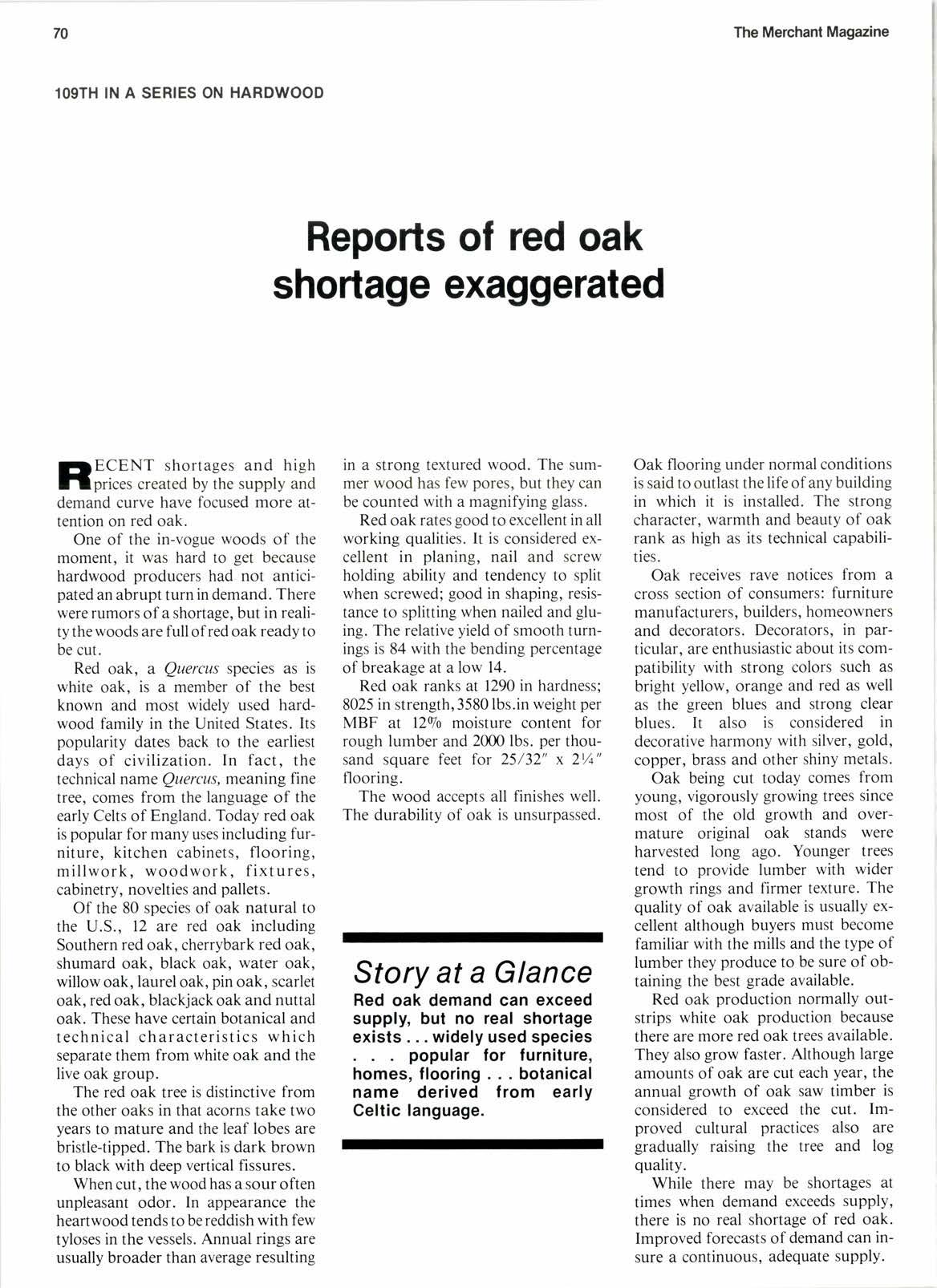
2 minute read
Reports of red oak shortage exaggerated
qECENT shorrages and high Eprices created by the supply and demand curve have focused more attention on red oak.
One of the in-vogue woods of the moment, it was hard to get because hardwood producers had not anticipated an abrupt turn in demand. There were rumors of a shortage, but in reality the woods are full of red oak ready to be cut.
Red oak, a Quercus species as is white oak. is a member of the best known and most widely used hardwood family in the United States. Its popularity dates back to the earliest days of civilization. In fact, the technical name Quercus, meaning fine tree, comes from the language of the early Celts of England. Today red oak is popular for many uses including furniture, kitchen cabinets, flooring, millwork, woodwork, fixtures, cabinetry, novelties and pallets.
Of the 80 species of oak natural to the U.S., 12 are red oak including Southern red oak, cherrybark red oak, shumard oak, black oak, water oak, willow oak, laurel oak, pin oak, scarlet oak, red oak, blackjack oak and nuttal oak. These have certain botanical and technical characteristics which separate them from white oak and the live oak group.
The red oak tree is distinctive from the other oaks in that acorns take two years to mature and the leaf lobes are bristle-tipped. The bark is dark brown to black with deep vertical fissures.
When cut, the wood has a sour often unpleasant odor. In appearance the heartwood tends to be reddish with few tyloses in the vessels. Annual rings are usually broader than average resulting in a strong textured wood. The summer wood has few pores, but they can be counted with a magnifying glass.
Red oak rates good to excellent in all working qualities. It is considered excellent in planing, nail and screw holding ability and tendency to split when screwed; good in shaping, resistance to splitting when nailed and gluing. The relative yield of smooth turnings is 84 with the bending percentage of breakage at a low 14.
Red oak ranks at 1290 in hardness: 8025 in strength,3580lbs.in weight per MBF at l29o moisture content for rough lumber and 2000lbs. per thousand square feet for 25/32" x 2Vq" flooring.
The wood accepts all finishes well. The durability of oak is unsurpassed.
Story at a Glance
Red oak demand can exceed supply, but no real shortage exists widely used species . popular for furniture, homes, flooring . . . botanical name derived f rom early Celtic language.
Oak flooring under normal conditions is said to outlast the life of any building in which it is installed. The strong character, warmth and beauty of oak rank as high as its technical capabilities.
Oak receives rave notices from a cross section of consumers: furniture manufacturers, builders, homeowners and decorators. Decorators, in particular, are enthusiastic about its compatibility with strong colors such as bright yellow, orange and red as well as the green blues and strong clear blues. It also is considered in decorative harmony with silver, gold, copper, brass and other shiny metals.
Oak being cut today comes from young, vigorously growing trees since most of the old growth and overmature original oak stands were harvested long ago. Younger trees tend to provide lumber with wider growth rings and firmer texture. The quality of oak available is usually excellent although buyers must become familiar with the mills and the type of lumber they produce to be sure of obtaining the best grade available.
Red oak production normally outstrips white oak production because there are more red oak trees available. They also grow faster. Although large amounts of oak are cut each year, the annual growth of oak saw timber is considered to exceed the cut. Improved cultural practices also are gradually raising the tree and log quality.
While there may be shortages at times when demand exceeds supply, there is no real shortage of red oak. Improved forecasts of demand can insure a continuous, adequate supply.










